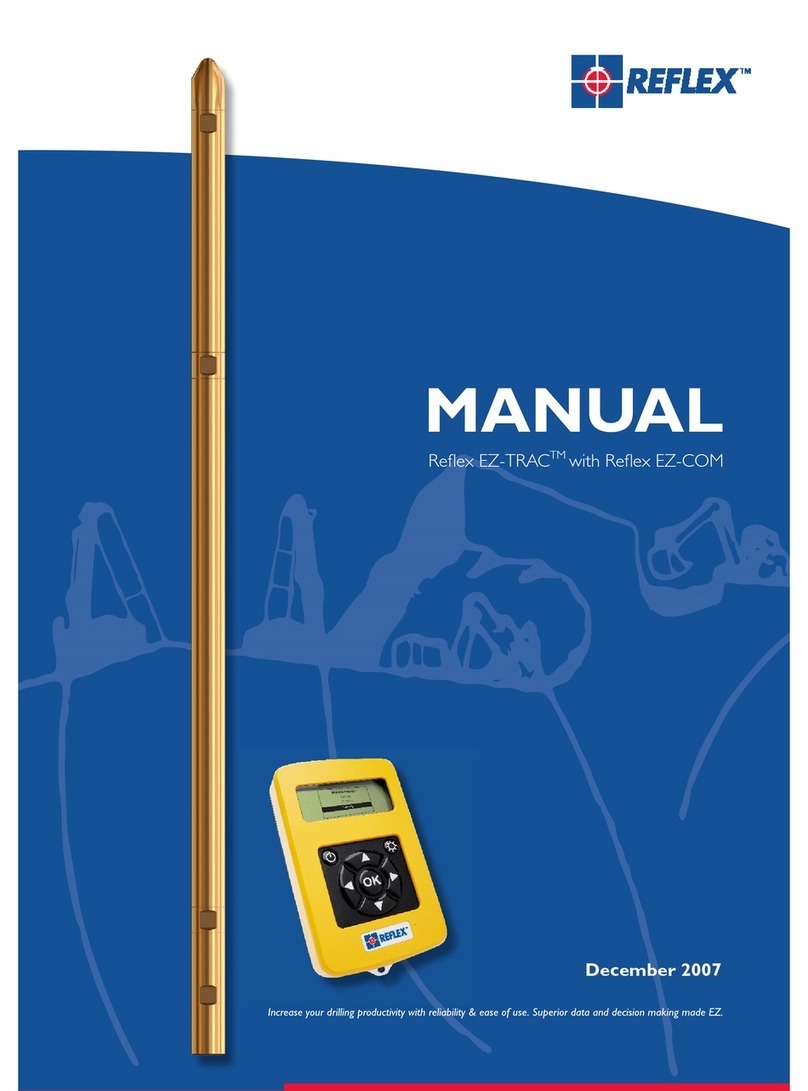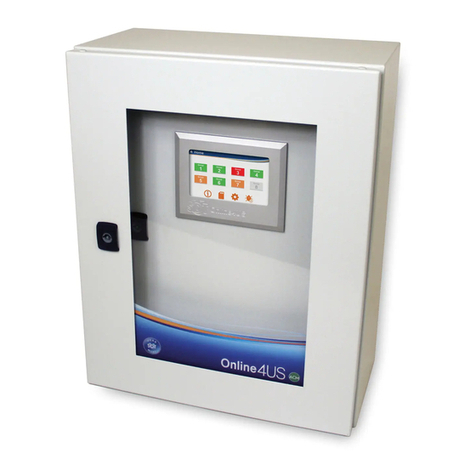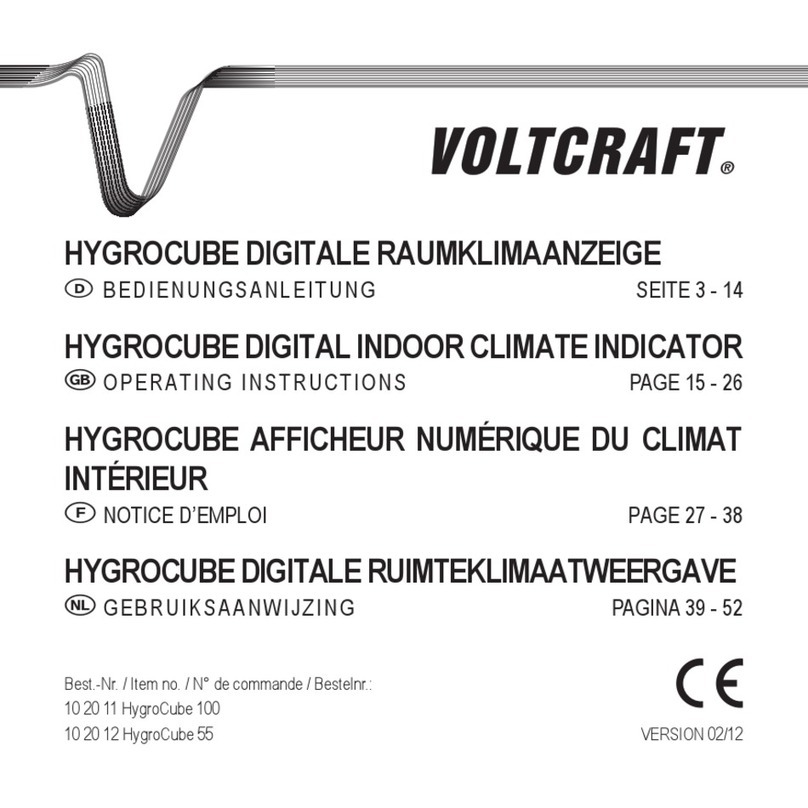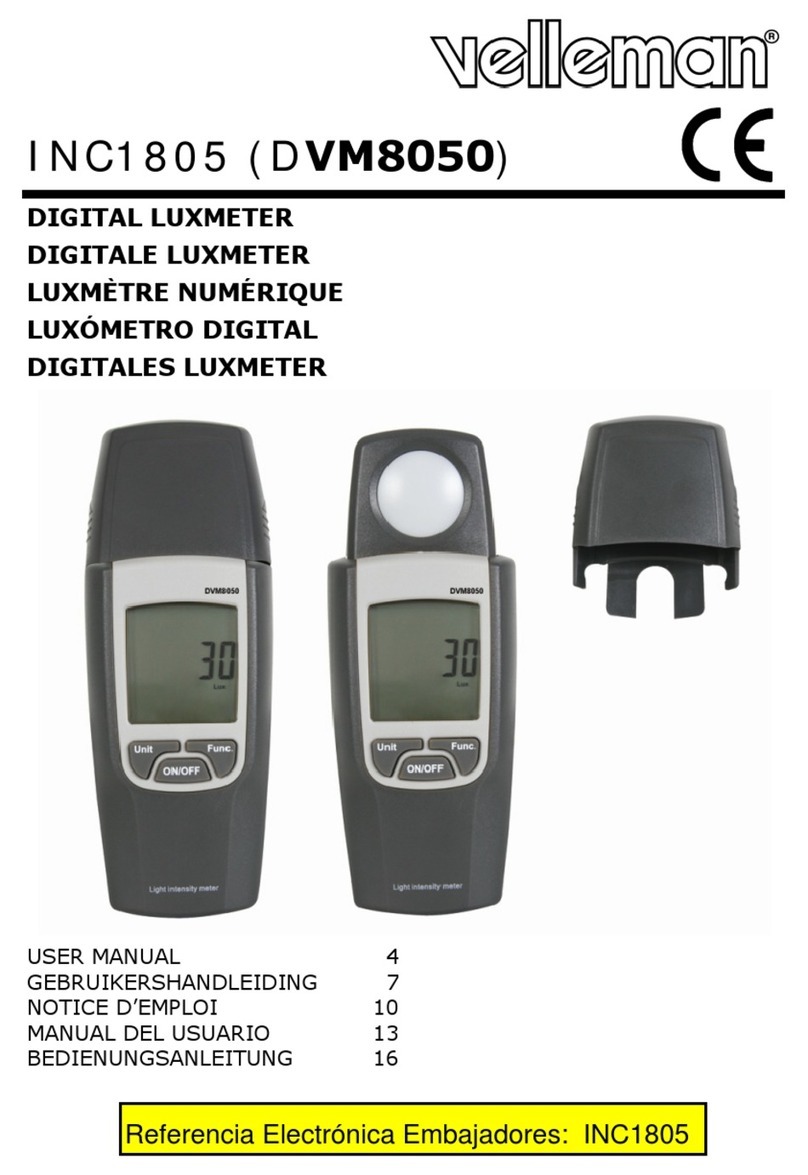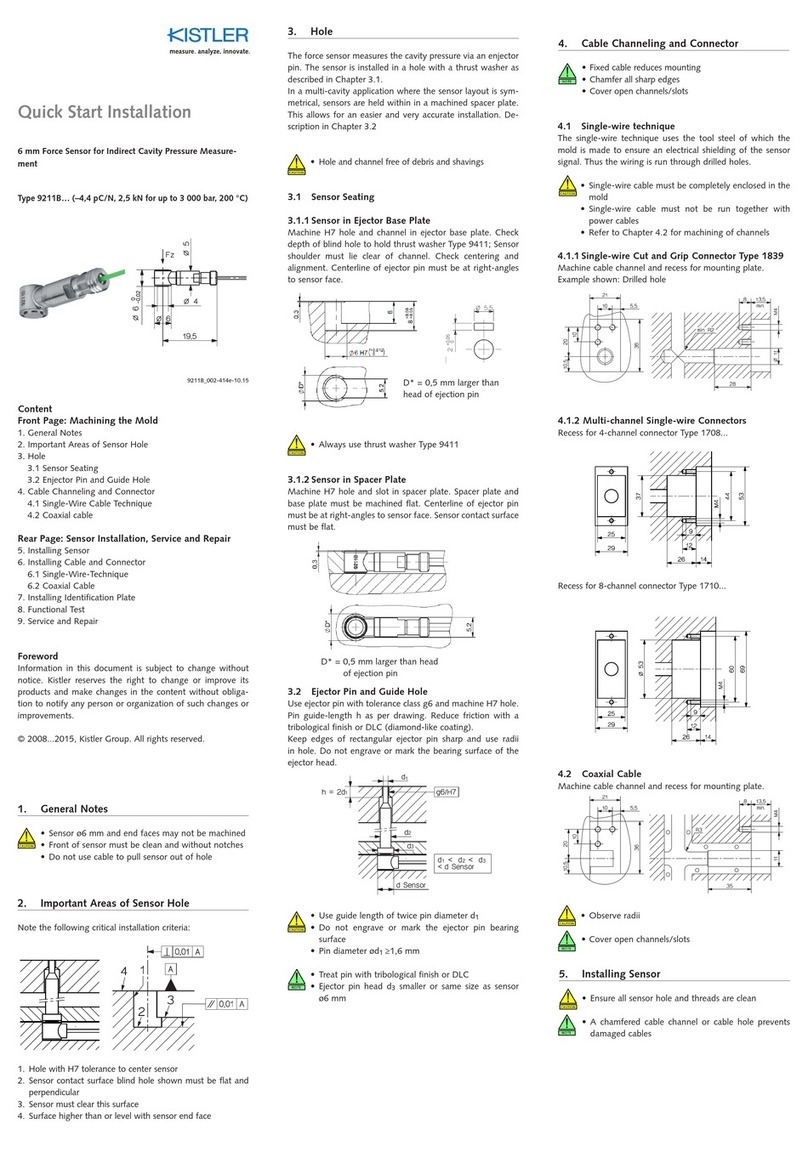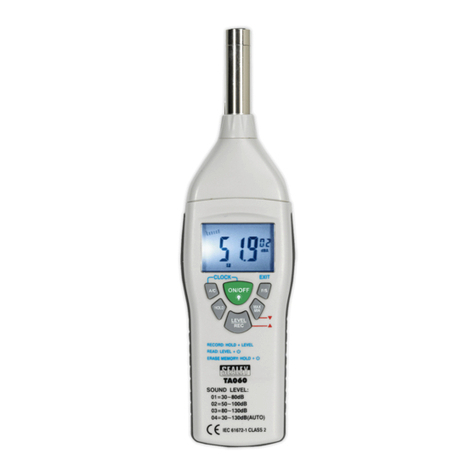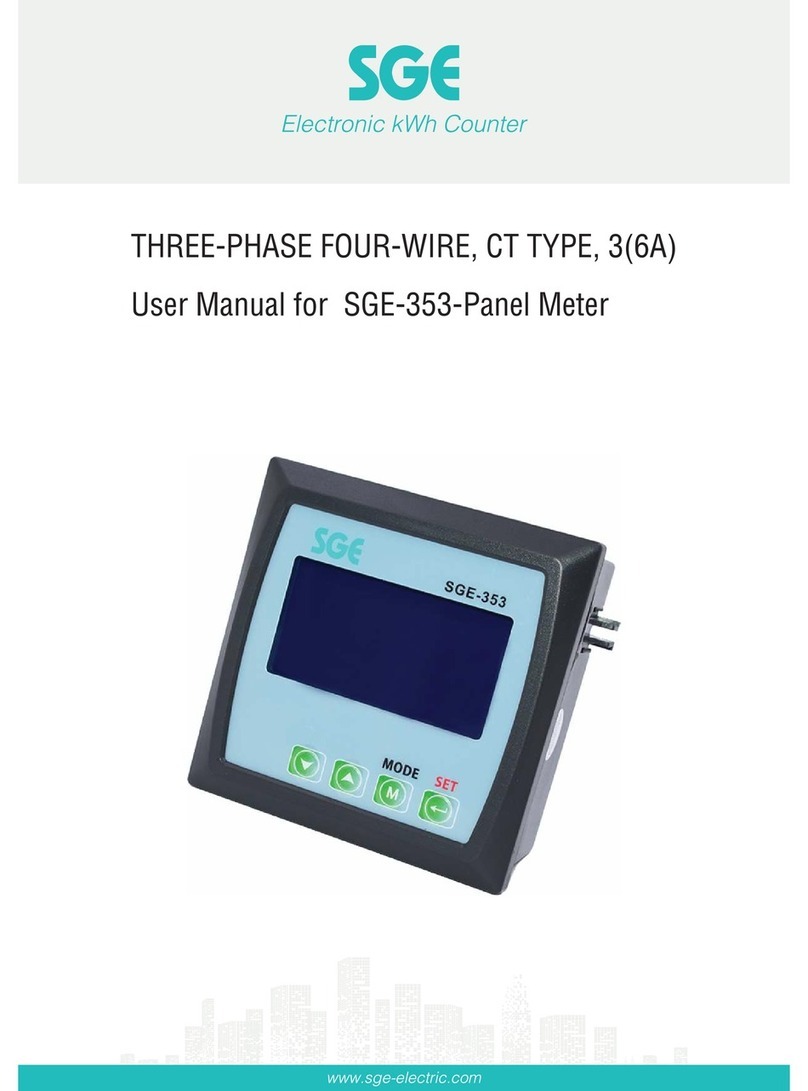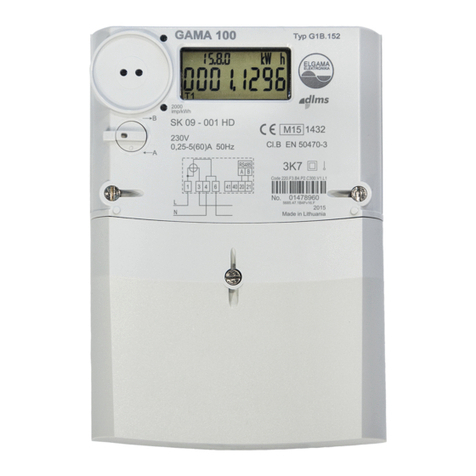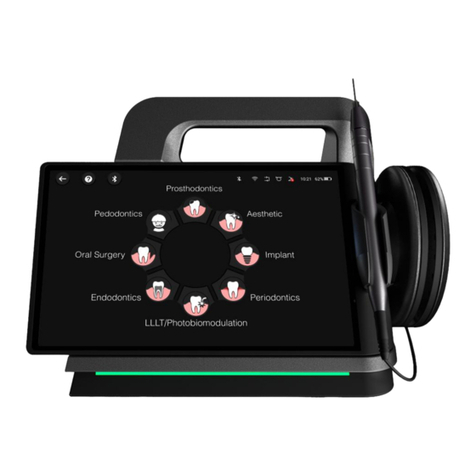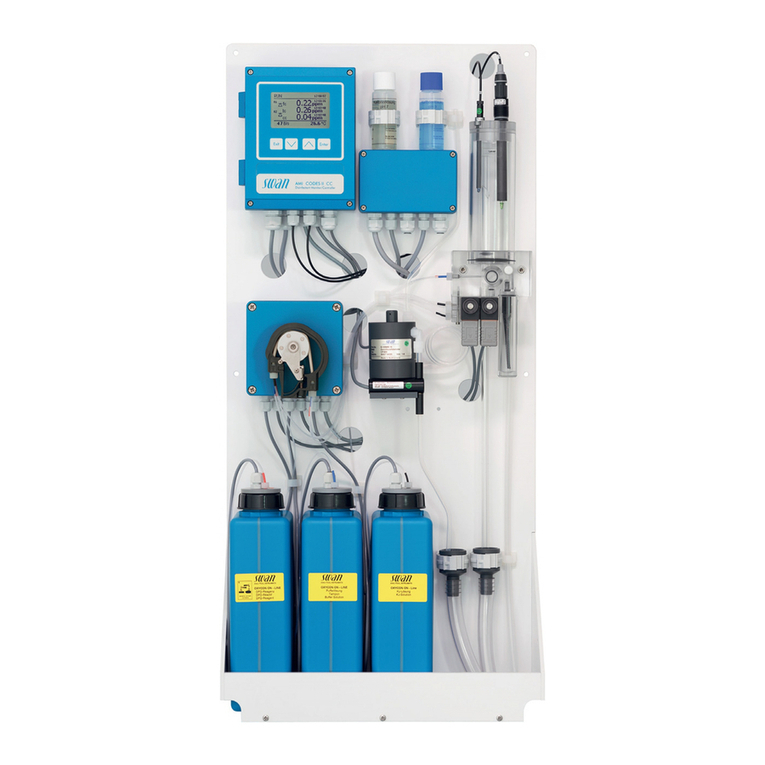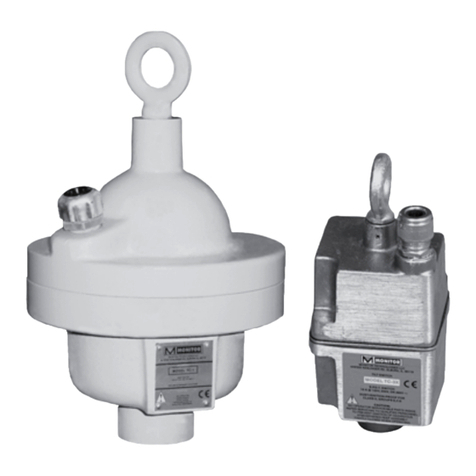FIBRO PGX+ PG1000 User manual



3 |
Warranty Statement
The model 68-76 Pocket Goniometer PGX+ is manufactured, sold and
distributed by Fibro System. We warrant this instrument to be free of defects
in performance, materials and workmanship. We will replace free of charge
and correct any defect in workmanship or performance without charge for
labor within a period of twelve (12) months from the date of purchase.
Our obligation under terms of this warranty is eective only if the defect
develops in a normal installation and under normal use and service and if the
model 68-76 Pocket Goniometer PGX+, is returned intact to our plant with
prior authorization and with all transportation charges prepaid, within twelve
(12) months from the date of purchase.
Our obligation to repair without charge is eective only, if the model
68-76 Pocket Goniometer PGX+ has been properly installed and used in
accordance with our written instructions. The complete terms regarding
instrument warranty can be requested at Fibro System.
Shipping Instructions
To ensure freedom from damage in shipment, the 68-76 Pocket Goniometer
PGX+ should always be repacked as it was when originally received including
the eventual transport protections.
Before shipping, an authorization to return should be secured from Fibro
System, by telephone, FAX or written letter. The best way to ship will also be
advised at that time.
In all correspondence concerning this instrument, please quote the model-
and serial number as given on the identication plate or as given on the info
screen of the instrument.
Product End-of-Life Handling
The equipment may contain substances that could be harmful to the
environment or human health. In order to avoid the release
of such substances into the environment and harm to human
health, we encourage you to recycle this product in an
appropriate system that will ensure that most of the materials
are reused or recycled appropriately. Please contact your local
authorities for disposal or recycling information.
Unpacking
The 68-76 Pocket Goniometer PGX+ is delivered in a carrying case
Check the instrument for transport damage. If damaged, contact your
insurance company and DO NOT throw away the packing as this is your
evidence. The accessories are packed in separate boxes and / or envelopes.
It is recommended to conserve the original box and inserts in case the
instrument needs to be transported. If the apparatus has to be returned
to the factory, it is strongly suggested to use the original packaging (see
warranty statement).

| 4

5 |
INDEX
1 Operator Safety 7
1.1 General information 7
1.2 Safety precautions 7
2 Introduction 8
3 ABOUT THE PGX+ 9
3.1 Instrument specications 9
3.2 PC specications 9
3.3 Scope of supply 9
3.4 Consumables and accessoiries 9
4 Setup Software 10
5 Calibration and Validation 12
5.1 Calibration Procedure (Perspex plate) 12
5.2 Validation Procedures 12
6 Setting up the instrument 13
6.1 Preparing a specimen 13
6.2 Special specimens 13
6.3 Pump dispenser 14
7 Software functions 15
7.1 Graphmaster camera 15
7.2 Graphmaster test 16
7.3 Graphmaster database 20
8 Test methods 21
8.1 Static Mode 21
8.2 Dynamic mode 22
8.3 Advancing mode 23
8.4 Superlow contact angles mode 24
8.5 Surface tenson 25
8.6 Wettability 26
8.7 Manual testing in static and dynamic mode 27
8.8 Surface ‘free’ energy (SFE) 27
8.9 Options screen 28
9 Application 29
9.1 Manual application 29
9.2 Automatic application 29
10 Trouble shooting 30
11 Miscellaneous 32
11.1 Instrument storage 32
11.2 Transportation 32
11.3 Droplets 32
11.4 Pump 33
11.5 Conversion chart 34

| 6


| 8
2 INTRODUCTION
The PGX+ measures contact angle (dynamic and static), surface tension, and
surface energy. The PGX+ makes a drop in µl according to the size that is
set. The drop is automatically released and 80 images per second are made.
The instrument is used for paper & board, solar cell panels, windshields,
metal cylinders and similar surfaces. For most tests deionized water is used,
however using other liquids is also possible. Contact us if you want to use
any other liquids.
During testing the instrument is connected to the special PC software. The
software gives you an easy overview of the possible tests. During the test
the data transferred to the computer. The pictures taken and the results
can be stored and analyzed. Thanks to the direct feedback, adjustments to
improve the results can easily be made.
Features:
• Easy to handle, small sized
• Registration with 80 frames/ second
• Automatic droplet creation and deposit
• Purity of liquids, Surface Tension, Static and Dynamic Contact
Angle
• Multiple test uids possible
• Runs on every Windows computer
• Power from USB connection
• No sample preparation
• Easy calibration
International Standards:
• TAPPI T458
• ASTM D-724
• ASTM D-5946

9 |
3 ABOUT THE PGX+
3.1 Instrument specications
Camera
Image Capture Rate: 80 frames/second
Field of View: 7,0 x 5,2 mm
Sensor Resolution: 640 x 480 pixels
Pixel resolution: 11 µm
Droplet application
Droplet Volume: 0,1 – 10 µl
Modes: Touch Down / Impact / Manual
Communication: USB 2.0
Operating conditions
Temperature: 10 - 35 °C
Humidity: 20 - 70%
Dimensions
Length: 90 mm
Width: 55 mm
Height: 90 mm
Net. Weight: ± 0.5 kg
3.2 PC specications
Minimum specications
1GB of RAM
20MB of free disk space
1024x768 screen resolution
USB port
Recommended system
Core i5 5th generation Intel (or compatible) processor
8GB of RAM
100MB of free disk space
1920x1080 screen resolution
USB port
Laser/Inkjet Printer
Operating systems
Windows Vista, Windows 7, Windows 8, Windows 8.1 or Windows 10
3.3 Scope of supply
Your PGX+ instrument is delivered in a carrying case (see picture) including
• PGX+ software
• one millilitre syringe
• calibration plate
• glass bottle
• PGX+ Accessory kit with syringe tip, pump tubing and applicator
tubing
NOTE:
Carefully check all small wrappings, boxes and envelopes in the large
corrugated box to be sure all parts and supplies, as listed on the packing list,
are present.
3.4 Consumables and accessoiries
Art. No. Description
PG1023 Liquid Container Kit (with & w/o plug), 5+5 pcs
PG1171 Steel cannulus tip 0.5 mm (min order quantity 10 pcs)
PG1025 Applicator Tubing between Syringe and Tubing Dispenser, 5 pcs
PG1021 Pump Tubing (PTFE) suitable for most liquids, 5 pcs
PG1027 Pump Tubing (Silicone) suitable for Diiodomethane, 2 pcs
PG1010 Dosing unit
1 Calibration plate
2 PGX Instrument
3 Syringe
4 Accessory Kit
5 Glass bottle
1 2
3 4 5


11 |
The rst time the instrument is activated also the Device Driver must be
installed.
Conrm the security message.
Connect the PGX+ instrument to the USB port you wish to use and I follow
the displayed instructions.
When the installation is terminated the new device 68-76 Pocked
Goniometer PGX+ is ready to use.
Double click on the device to start the Test software
Note
If only one instrument is present the software GraphMaster Test will be
launched automatically.
Before performing the test the instrument must be calibrated.
See Chapter Calibration.

| 12
5 CALIBRATION AND VALIDATION
of the calibration plate and perform a measurement in Static Mode. If these
values are regularly stored, this information can be used for monitoring of the
calibration/validations.
5.2.2 ISO Calibration plates (metal)
Select “Calibrate”from the Image Control Panel and place the PGX+
instrument on top of the semi- sphere and push the instrument gently
against the calibration plate surface. This“articial droplet” is now measured
continuously. Enter the height of the reference found on the calibration
plate. If the data are inside the tolerances, all numbers will be displayed in
green. If one or more numbers are displayed in red, the instrument must be
re-calibrated
Your PGX+ instrument has been carefully assembled and checked during
production. It should not be necessary to do any further adjustments. For a
correct performance, however, the instrument must be calibrated according
to the procedure below. Without a correct calibration the instrument
readings will be incorrect.
NOTE:
Before calibration, your instrument should be connected to the USB port for
30-60 minutes in room conditions. Make sure the drop applicator is installed
to avoid stray light shining into the instrument as this may have an impact on
the calibration.
5.1 Calibration Procedure (Perspex plate)
a) The steel ball must have its top 2.6-3.0 mm above the Perspex sur-
face. With a steel ball outside these dimensions calibration might fail.
b) Select “Calibrate”from the Instrument menu
c) Locate the reference mark at the edge of the instrument sole.The
calibration plate has a similar mark indicating the ”full sphere”.
Place the PGX+ instrument on top of the calibration plate with its
reference mark positioned above the dot as indicated in the picture.
Push gently on top of the instrument to make sure the instrument
rests rmly against the calibration plate surface.
d) Click on the [Start] button to nd the optimum Threshold setting.
e) Next the automatic scale factors are determined from the image. This
is a high precision operation, which requires a clean sphere. If defects
are detected an error message ”Unable to nd sphere”will appear. If
debris is found at the sphere contour, remove the instrument from
the calibration plate and clean the steel ball with a cotton swab
dipped in Isopropanol. Select“Camera”and “Calibrate”to restart the
calibration routine.
f) When the calibration routine has terminated, the results are
displayed for the semi-sphere above the diameter with the following
target numbers:
- Height (c-top) = 1,00 ± 0.02 mm
- Diameter = 2.00 ± 0.04 mm
- Volume = 2.09 ± 0.4 µl
- Contact Angle = 90.0 ± 1°
NOTE:
Accepted values will appear in green.
g) Click on [Save] to store the calibration data.
5.2 Validation Procedures
To verify a correct instrument reading it is much faster to “validate”the
instrument using one of the two validation procedures described below. It is
recommended to validate the instrument readings at regular intervals.
5.2.1 Standard Calibration plates (Perspex)
Select “Calibrate”from the Image Control Panel and place the PGX+
instrument on top of the full sphere and push the instrument gently
against the calibration plate surface. This“articial droplet” is now measured
continuously. If the data are inside the tolerances, all numbers will be
displayed in green. If one or more numbers are displayed in red, the
instrument must be re-calibrated (Section 5).
NOTE:
An optional way to validate the instrument is to place the instrument on top

13 |
6 SETTING UP THE INSTRUMENT
The 68-76 Pocket Goniometer PGX+ is powered directly from the USB cable,
it is not require external power or batteries.
Warning:
The instrument must be connected to a port USB2.0 or higher.
Insert the Pump Dispensing Unit into the centre of the Applicator Tube.
NOTE:
The dispensing tip should now appear at the top of the live video image
6.1 Preparing a specimen
Determine and mark the machine direction of each sample where applicable.
Be careful not to touch the areas to be tested, or contaminate them in any
other way.
Determine and mark the “top”and“back” sides of each sample based on
the side relevant for the application. The test areas must be free of folds,
wrinkles, blemishes, watermarks and other defects not normally inherent in
the sample.
Note: If the PGX+ instrument is used in the MD direction and then the CD
direction, the ratio between BaseCD to BaseMD at an agreed time (e.g. one
second) can be used to determine the anisotropy of a surface. For testing of
anisotropic surfaces (e.g. newsprint) the PGX+ instrument should be oriented
at a 45° angle to the machine direction when it is not necessary to determine
the degree of anisotropic response.
Soft materials (e.g. tissues, textile, and lm) or warping materials (e.g.
newsprint, cigarette tipping paper) should be mounted on top of a at
backing material using a soft-sticky adhesive material.
A) Place the PGX+ instrument on top of the specimen.
B) Check to make sure the test surface appears horizontally in the
image.
NOTE:
Soft and warping materials should be placed on a proper backing to hold it
at. A good backing is at, sti and coated with a soft-sticky surface, which
does not pull lint from the specimen surface when removed.
6.2 Special specimens
In certain applications, the test might require special arrangements like a
xture, into which the test specimen can be inserted. One example is a metal
can or a round glass bottle where it will be necessary to position the droplet
at the highest point of the curved surface.
NOTE:
Please note the groove at the centre of the instrument sole!
If the instrument is placed perpendicular across a test object with small
radius (see picture) the test surface will appear higher in the image than
normal. The instrument can then be placed in the direction of the object axis
(see picture)).
We can also provide special PGX+ accessories for testing on electronic
circuit boards and tablets. Contact your instrument supplier for additional
information.
Testing curved surfaces perpendicular to the object axis
Testing curved surfaces in the direction of the object’s axis

| 14
6.3 Pump dispenser
The test liquid is applied from the built-in micro-pump via the pump
applicator unit. It is suggested the pump system is used for a single standard
test liquid (e.g. water or fountain solution).
Use dierent tuning for each test liquid to avoid contamination!
To pump liquids of higher viscosity or to determine the wetting hysteresis
(advanced/receding contact angles), it will be necessary to use the optional
PG Dosing Unit.
The integrated micro pump is designed for a standard liquid (e.g. water)
where the droplet size can be set in steps of 0,5 µL.
• Press the PUMP button to pump out a new droplet.
• If PUMP is pressed until the LED is lit, the droplet is slowly lowered
towards the test surface, which is recommended for measurements
in Static Mode;
• If PUMP is pressed momentarily, the LED will blink while the droplet
is pumped out. It is then lifted a short distance from which it is
dropped towards the surface. This approach is recommended for
Dynamic Mode measurements.
• Press PUMP a second time during the pump sequence to inhibit
application of the droplet.
The liquid system is lled in the following way:
a) Place the instrument on top of a at surface
b) Locate the tiny air hole on top of the white container lid. Use the
attached one millilitre syringe with the RED tip to ll the container
with distilled water.
NOTE:
DO NOT use tap water, as this will leave residuals inside the liquid
system!
c) Insert the RED dispensing tip into the air hole to ll the container.
Check top of liquid container to see when liquid container is full
(See picture)
d) Check the pump lid screw is tightened. (see picture)
e) Fill the pump tubing like this:
- Set the volume selector to position FILL.
- Press PUMP and the pump will be activated to give 50 pump
strokes before it stops.
This volume (25 µL) may produce a small droplet at the dispensing
tip. If not, press once more on the PUMP button to restart pump.
When all air is removed and a droplet appears at the dispensing tip:
press and hold the PUMP button until pump stops.
f) Set the volume selector to “4,0 µL”, which is the default droplet size
for testing (see chapter“ Miscellaneous”).
g) The instrument is now ready for a test (see Section 8.).
Tighten the pump lid screw
Filling the Liquid Container

15 |
7 SOFTWARE FUNCTIONS
7.1 Graphmaster camera
The Camera screen will always reside on top of the other screens, if not you
can recall it from the taskbar.
Its size is adjustable to not interfere with other windows.
Double-click on the image to switch the live image between greyscale and
binary (black/white) mode.
Click with the right button on the image to open the context menu
7.1.1 Save image
It allows to save the live image in a BMP le.
7.1.2 Driver version
It shows the information about the driver and module load.

| 16
7.1.3 Advanced conguration
7.1.4 Service
7.1.5 Exit
It allows to close the Camera window even if the software doesn’t reply.
7.2 Graphmaster test
This manual covers only the functions specic for the 68-76 Pocket
Goniometer, see the GraphMaster manual for all other information.
7.2.1 Select test procedure

17 |
Static
is designed to capture a single reading of the static contact angle at
”equilibrium”. This value can be measured on smooth, non-porous surfaces
not penetrated by the test liquid. Typical examples are water droplets on
hydrophobic release papers and polymer barriers (e.g. liquid container board).
Dynamic
captures a video sequence during the interaction between the liquid and
the surface. Here the dynamic wetting (contact angle), liquid penetration
(volume) and spreading are measured as a function of time.
Advancing
is designed to characterize the“wetting hysteresis”as a liquid droplet
advances across a dry surface and then retracts from a wet surface. This
measurement requires a reversible pump ow, which is not possible to do
with the micro pump built into the PGX+ Measuring Head.
SuperLow
is designed for measurement of very low static contact angles below 10
degrees related to super clean surfaces.
Surface Tension
enables testing of the purity of the test liquid. A suciently big pendant
droplet is pumped out at the dispensing tip and the surface tension is
determined from the droplet shape.
Wettability
is a dynamic test with specic calculation for wettability.
7.2.2 Camera settings
Gain oset
This feature modies the live camera image in real time. This way the full
dynamic range is always available even when the test substrate appears ”too
dark” or ”too bright” due to variations in light reectance.
Double click on the label “Gain Oset” to restore the default value (24).
Exposure oset
This feature modies the live camera image in real time. This way the full
dynamic range is always available even when the test substrate appears ”too
dark” or ”too bright” due to variations in light reectance.
Double click on the label “Exposure Oset” to restore the default value (0).
Enhance
This feature brings out the droplet image even in situations where the
droplet base is partially hidden on a dark, light-absorbing surface.
When a water droplet is applied on a surface of low reectance (e.g. dark,
rough craft liner), the droplet base will appear against a dark background.
If the light level is increased, or the parameter camera Oset Gain and/
or Oset Exposure are adjusted to distinguish the droplet base from its
background, the droplet top can become too bright against the illuminated
background. This is where the image enhancing routine will be very helpful.
• Double click on the label “Enhance”to restore the default value (0).
• Place the instrument on the test surface and apply a liquid droplet
on the surface.
• Double-click in the video image to switch from greyscale to a binary
image if necessary.
• Adjust the Camera Gain control until the top of the droplet is com-
pleted. Then use the Enhance control to create a solid black contour
all the way down to the base of the droplet.

| 18
7.2.3 Elaboration image
The windows is open with a double click on the image from the main page
Elaboration Image allows to change the points where the measurement are
done.
Adjust the position of an incorrect Base line
When the automatic base line is set incorrectly, keep press Shift and use the
“Page Up” and “Page Down“ keys or pick up the base line handle (1) with the
mouse and slide it to the correct position.
Adjust the position of droplet contour
When the automatic contour is set incorrectly, keep press Shift and use the
cursor to move the contour to the correct position.
Adjust the dimension of droplet contour
When the automatic contour is incorrectly, keep press Shift and use the “+”
and “-“keys to change the dimension of the contour to the correct dimension.
These images will then be recalculated with the new base line setting.

19 |
Update the values
Once the contact angle is measured in the correct position, press one of the
buttons (3) to re-calculate the measurement with the new settings.
The dimension and position of the contour is used only for the selected
image, the baseline position can be used to recalculate all the images or only
the forward images.
Fix baseline position
If the option “Fix” is selected the new baseline position will be used for all the
future tests.
Use the slider below the image (2) to shift to another image.
7.2.4 Hardware settings
Hardware Setting allows to customize the software
Minimum height
Denes the minimum height of a droplet (reduce for smooth surfaces)
Default value = 10
Sobel Filter
Enable the Sobel lter to improve measurements on rough surface but it can
increase the stability of the readings.
Default = false
Auto Detect
Denes the distance to the trigger line in Dynamic Mode
Default = 25
Seek Area
Seek Range for Advancing/ Receding function
Default = 40
Low Gain
Use a low gain in the SuperLow method
Default = false
Correction
Correction method in surface tension procedure.
Default = true
Curtain
The curtain allows to avoid to analyze the top part of the image.
The value is expressed in pixel.
Default = 60
Always Show Volume
It shows always the volume of the droplet.
Default = false
Hanging Time
Delay from the end of the pumping operation and the release of the droplet.
Default = 1

| 20
7.2.5 Calibration
7.3 Graphmaster database
7.3.1 Surface energy
The Surface Energy functions is available only for the Static and Dynamic
mode.
The function is enabled only when 2 or 3 records are selected.
This manual suits for next models
1
Table of contents


